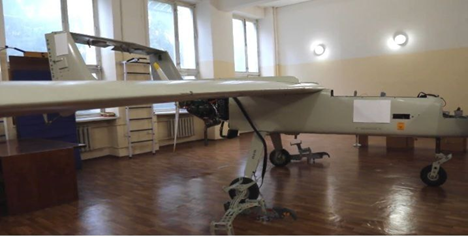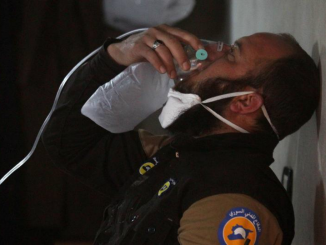
New intelligence collected from downed Iranian drones in Ukraine shows that a majority of the aircrafts’ parts are manufactured by companies in the U.S., Europe and other allied nations, reported the Wall Street Journal.
This raised concern among Western officials and analysts and prompted a U.S. government investigation, according to people familiar with the matter and documents reviewed by the Journal.
The documentation of Western parts shows how Tehran has been arming itself and its allies with powerful new weaponry despite being the target of one of the most comprehensive sanction regimes in modern history.
Ukrainian intelligence estimates that three-quarters of the components of the Iranian drones downed in Ukraine are American-made, according to documents reviewed by the Journal.
The findings were made after the Ukrainian military downed several drones, including an Iranian Mohajer-6 drone that agents hacked midflight and landed intact, according to Ukrainian investigators. The components, identified by Ukrainian military intelligence, were verified by the Independent Anti-Corruption Commission, a Kyiv-based nonprofit that inspected the drone.
Self-destructing drones play a key role in Russia’s strategy to strike cities and civilian infrastructure in Ukraine. Clues in videos and photos indicate that unmanned aerial vehicles are provided by Iran, despite Moscow’s denials.
Out of more than 200 technical components identified by Ukrainian investigators that make up the innards of the captured drone, roughly half were made by firms based in the U.S., and nearly a third by companies in Japan, according to the report.
Iran is exporting sophisticated, low-cost drones in the Middle East and now in Ukraine’s frontlines, notably:
MOHAJER-6:
Unmanned aerial vehicle capable of carrying a multispectral surveillance payload alone or with two precision-guided munitions. Max speed: 124 mph / Max flying range: 124 miles / Weight: 1,323 lbs. / In service: 2018 / Origin: Iran.
SHAHED-136:
A suicide drone equipped with an explosive warhead. Max speed: 115 mph / Max flying range: Up to 1,553 miles / Weight: 441 lbs. / In service: 2021 / Origin: Iran.
Iran’s mission to the United Nations didn’t respond to questions about its use of Western parts, but said that Tehran “is ready to meet with Ukraine at the level of technical experts and investigate drone- or parts-ownership claims.”
U.S. sanctions imposed across Iran’s economy were intended in part to cut the country off from the international financing and trade needed to fund and develop its military, including drones. Similarly, prohibitions in the U.S. and Europe on exports of commercial components that could be used for advanced weaponry are designed to prevent Iran and other foes from gaining from the West’s technical expertise.
The Western-made components that appear to guide, power and steer the drones present a vexing problem for world leaders trying to contain Iranian weapons development and proliferation. Iran’s fleet of unmanned military aircraft, along with the precision-guided missiles they can carry, is now seen by Western security officials as a bigger immediate threat than Iran’s nuclear program.
“A priority is understanding how foreign parts are ending up in Iranian drones,” said David Albright, founder of the Washington-based Institute for Science and International Security, which published its own analysis of Iranian drones last month.
The institute’s report said that besides Western components, there is also evidence that Chinese companies might be supplying Iran with copies of Western commodities to produce the combat drones.
The U.S. federal agency responsible for enforcing export controls, the Commerce Department’s Bureau of Industry and Security, launched an investigation into the Western-origin parts, according to industry officials familiar with the matter.
A senior Commerce Department official declined to comment on any particular situation but said “the proliferation of weapons into Ukraine for use against Ukrainian people is a top priority for us, and we’re going to investigate any illegal export that might be connected with that effort.”
Russia began using Iranian drones to attack critical infrastructure after a series of Ukrainian battlefield successes through the summer months sent its Russian forces into retreat. Tehran’s Shahed-136 model caught immediate public attention when Russia began using the unmanned aircraft, dubbed kamikaze drones because they strike targets by crashing into them, rather than launching weapons.
The Western-made components underscore the difficulty authorities have trying to stem Tehran’s proliferation of its drones.
Many of the parts aren’t under export controls, and can easily be bought over the internet and shipped to Iran through other countries that draw less attention, according to industry and Western security officials. Such transshipments are a violation of law, though they can be difficult to prevent, those people say.
The U.S. Treasury sanctioned on Tuesday several Iranian, Russian and United Arab Emirates companies and individuals it said are responsible for the production and transfer of the Iranian drones used by Russia in Ukraine.
The servomotors in the Mohajer-6, which allow operators to maneuver the unmanned craft through the air, were made by Japan’s Tonegawa-Seiko Co., according to Ukrainian intelligence documents and NAKO’s report.
Japan’s Trade Ministry last year charged the firm for exporting servomotors to China without a permit after U.N. investigators found one of the parts in an Iranian drone. The company told local media that it didn’t know they would be used in military drones.
A host of other electronic components were manufactured by units of German-owned Infineon Technologies AG and Arizona-based Microchip Technology Inc., two of the world’s top-tier chip manufacturers, according to the intelligence and NAKO report.
Brian Thorsen, a spokesman for Microchip Technology, said the firm “takes care to maintain supply-chain integrity,” which includes screening clients. He also said that besides having more than 120,000 customers in the industrial, aerospace, defense and other sectors, third-party distributors also sell its products around the world.
“Without access to the device itself, we are unable to advise whether it is a Microchip product or counterfeit product, and if it is a Microchip product, how it ended up in this particular application,” Mr. Thorsen said.
An Infineon spokesman said the company doesn’t sell any of its products to Iran.
The high-resolution telescopic infrared lens used in the Mohajer-6 for surveillance and targeting appears to be identical to a model made by an Israeli firm, Ophir Optronics Solutions Ltd., according to photos of the device in the Mohajer-6 and corporate brochures reviewed by the Journal. The company declined to comment.
MKS Instruments Inc., Ophir’s parent company, said that it doesn’t sell to Iran and that it abides by U.S. or other applicable laws, including export controls and sanctions, according to the Journal.



